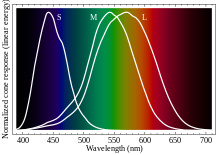Trichromacy

Trichromacy is a type of color vision. Animals with this kind of vision see colors with cone cells in their retina. The three types of cone cell are sensitive to different wavelengths of light. Color is constructed in the brain's visual cortex. Humans and many other primates have full color vision.[1] Most mammals do not, because they have only one or two types of cone cells, which do not discriminate so many distinct wavelengths. Most other vertebrates such as lizards and birds have four types of cone cells, hence can discriminate more colors than humans can.
